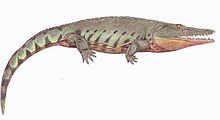| Chroniosuchidae Temporal range: | |
|---|---|
 | |
| Chroniosuchus | |
| Scientific classification | |
| Domain: | Eukaryota |
| Kingdom: | Animalia |
| Phylum: | Chordata |
| Order: | † Chroniosuchia |
| Family: | † Chroniosuchidae Vjuschkov, 1957 |
| Genera | |
Chroniosuchidae is a family of semi-aquatic tetrapods found in sediments from the upper Permian and the upper Triassic periods, most in Russia. They were generally rather large animals, with long jaws similar to those found in modern crocodiles, and probably lived a similar lifestyle as riverside piscivores and ambush predators. Like all chroniosuchians, they bore extensive osteoderm armour on their backs, possibly as protection against terrestrial predators such as the Permian therapsids and the Triassic rauisuchians.


